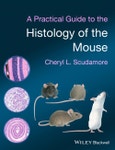This book is aimed at veterinary and medical pathologists who are unfamiliar with mouse tissues and scientists who wish to evaluate their own mouse models. It provides practical guidance on the collection, sampling and analysis of mouse tissue samples in order to maximize the information that can be gained from these tissues. As well as illustrating the normal microscopic anatomy of the mouse, the book also describes and explains the common anatomic variations, artefacts associated with tissue collection and background lesions to help the scientist to distinguish these changes from experimentally- induced lesions.
This will be an essential bench-side companion for researchers and practitioners looking for an accessible and well-illustrated guide to mouse pathology.
- Written by experienced pathologists and specifically tailored to the needs of scientists and histologists
- Full colour throughout
- Provides advice on sampling tissues, necropsy and recording data
- Includes common anatomic variations, background lesions and artefacts which will help non-experts understand whether histologic variations seen are part of the normal background or related to their experimental manipulation
Table of Contents
List of contributors ixForeword xi
Preface xiii
About the companion website xv
Chapter 1 Necropsy of the mouse 1
Lorna Rasmussen and Elizabeth McInnes
1.1 Recording of findings 2
1.2 Bleeding technique 3
1.3 Perfusion 3
1.4 External examination 4
1.5 Weighing of organs 6
1.6 Positioning of mouse for necropsy and removing the skin 6
1.7 Opening the abdominal cavity and exposing organs 9
1.8 Removing the ribcage to expose lungs and heart 17
1.9 Removing the brain and spinal cord 20
1.10 Collecting and fixing tissue samples 22
References 22
Chapter 2 Practical approaches to reviewing and recording pathology data 25
Cheryl L. Scudamore
2.1 Sample selection and trimming patterns 26
2.2 Controls 28
2.3 Standardizing terminology 28
2.4 Microscopic terminology 30
2.5 Recording pathology data 33
2.6 Quantitative versus semiquantitative analysis 35
2.7 Semiquantitative techniques 37
2.8 Quantitative techniques 38
References 40
Chapter 3 Gastrointestinal system 43
Cheryl L. Scudamore
3.1 Background and development 43
3.2 Oral cavity 43
3.3 Salivary glands 46
3.4 Stomach and intestines 48
3.5 Liver 56
3.6 Pancreas 59
References 61
Chapter 4 Cardiovascular system 63
Cheryl L. Scudamore
4.1 Background and development 63
4.2 Sampling techniques and morphometry 63
4.3 Artefacts 65
4.4 Anatomy and histology of the heart 67
4.5 Anatomy and histology of the blood vessels 69
References 72
Chapter 5 Urinary system 75
Elizabeth McInnes
5.1 Background and development 75
5.2 Sampling techniques 76
5.3 Artefacts 76
5.4 Background lesions 77
5.5 Anatomy and histology 79
References 85
Chapter 6 Reproductive system 87
Cheryl L. Scudamore
6.1 Background and development of the male and female reproductive tract 87
6.2 Female reproductive tract 88
6.3 Male reproductive tract 97
References 105
Chapter 7 Endocrine system 109
Ian Taylor
7.1 Introduction 109
7.2 Adrenals 109
7.3 Pituitary 114
7.4 Thyroids and parathyroids 117
References 121
Chapter 8 Nervous system 123
Aude Roulois
8.1 Introduction 123
8.2 Necropsy 123
8.3 Fixation/perfusion 126
8.4 Trimming 131
8.5 Special stains and techniques 133
8.6 Microscopic examination 137
8.7 Normal histology-juvenile – CNS and PNS 137
8.8 Artefacts – CNS and PNS 141
8.9 Pathological changes and background pathology – CNS and PNS 142
8.10 Acknowledgment 146
References 146
Useful website resources 148
Chapter 9 Lymphoid and haematopoietic system 149
Ian Taylor
9.1 Introduction 149
9.2 Lymph nodes 150
9.3 Spleen 156
9.4 MALT (mucosa-associated lymphoid tissue) 160
9.5 Thymus 161
9.6 Bone marrow 164
References 166
Chapter 10 Integument and adipose tissue 169
Cheryl L. Scudamore
10.1 Background and development 169
10.2 Sampling technique 170
10.3 Anatomy and histology 171
References 177
Chapter 11 The respiratory system 179
Elizabeth McInnes
11.1 Background and development 179
11.2 Embryology 179
11.3 Anatomy and histology of the respiratory system 180
11.4 Upper respiratory tract 180
11.5 Lower respiratory tract 189
References 193
Chapter 12 Special senses 195
Cheryl L. Scudamore
12.1 Background and development 195
12.2 Sampling technique for the eye 195
12.3 Artefacts 197
12.4 Anatomy and histology of the eye and associated glands 199
12.5 Background and development of the ear 204
12.6 Sampling technique for the ear and associated structures 205
12.7 Anatomy and histology of the ear and associated glands 206
References 209
Chapter 13 Musculoskeletal system 211
Cheryl L. Scudamore
13.1 Background and development 211
13.2 Sampling techniques 211
13.3 Anatomy and histology 212
References 218
Index 221








